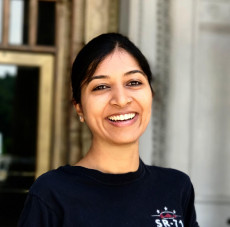Reva Jambunathan Takes First Place in Berkeley Lab SLAM
CRD Postdoc Wins With Talk on Simulating Pulsar Magnetospheres with AMReX, WarpX
September 18, 2020
What starts out 10 times the size of our sun, runs out of fuel, and collapses into a dense object about the size of Berkeley?
Answering that question landed postdoc Revathi Jambunathan of CRD's Center for Computational Sciences and Engineering first place in the annual Berkeley Lab SLAM held Thursday, Sept. 17.
Jambunathan, who was the only Computing Sciences postdoc among a dozen SLAM finalists, works on the development of WarpX. The electromagnetic particle-in-cell code is used primarily for simulations of advanced plasma wake-field accelerators using advanced algorithms, but Jambunathan is working to extend its use into astrophysics.
"Recently, we have started extending WarpX to also simulate particle acceleration in astrophysical processes, such as pulsar magnetospheres and magnetic reconnection," Jambunathan said. "The fact that AMReX and WarpX are open-source codes that will benefit a broader plasma community makes this work even more satisfying."
Revathi Jambunathan delivered her talk to a live audience via Zoom. Like all SLAM participants, she was allowed one slide and three minutes to explain her research in a lay-friendly way that wowed the judges.
The mysterious objects at the heart of Jambunathan's talk spin faster than a Formula 1 car engine even though just a teaspoon of these objects weighs as much as Mt. Everest. WarpX can help address the computational challenges of modeling these objects, which will further our understanding of the Universe.
The SLAM's second-place prize, a tie, went to Sara Gushgari-Doyle, Earth & Environmental Sciences, and Mariah Parker, Energy Sciences. The People's Choice, the finalist that had the most votes from the audience, was Jonelle Basso, Biosciences Area. The competition was held live over Zoom and recordings are expected to be available shortly for those who missed the event.
Videos of the entire competition as well as excerpted finalists' presentations are available in this YouTube playlist.
About Berkeley Lab
Founded in 1931 on the belief that the biggest scientific challenges are best addressed by teams, Lawrence Berkeley National Laboratory and its scientists have been recognized with 16 Nobel Prizes. Today, Berkeley Lab researchers develop sustainable energy and environmental solutions, create useful new materials, advance the frontiers of computing, and probe the mysteries of life, matter, and the universe. Scientists from around the world rely on the Lab’s facilities for their own discovery science. Berkeley Lab is a multiprogram national laboratory, managed by the University of California for the U.S. Department of Energy’s Office of Science.
DOE’s Office of Science is the single largest supporter of basic research in the physical sciences in the United States, and is working to address some of the most pressing challenges of our time. For more information, please visit energy.gov/science.










